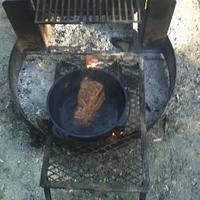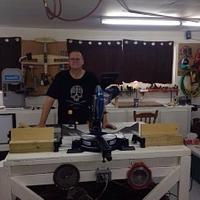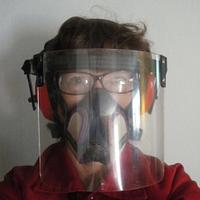
christiebiscuit
in almost 11 years
Planer questions from the new guy
Hi everyone from Fergus Ontario,
I’ve been a machinist for 25+ years now and last year inherited a bunch of wood working tools. A small table model Delta band saw, a craftsman 10 inch table saw and a Ryobi 10 inch planer. These are all probably 15+ years old. I hadn’t done anything with wood since about the mid 1970’s. I have made a bunch of band saw boxes because they seemed relatively easy. (other than a lot of sanding) I have a bunch of questions about how to use a bench top planer. How do I go about planing a board. How do you know what height to start your first cut at. I’ve tried checking out some of the videos on youtube but they are very vague and only seem to deal with tear out and snipe. Any suggestions on where to start would be greatly appreciated. I’d like to try buying some rough sawn wood instead of paying to have it planed down to the dimensions I require.
20 Replies
It’s pretty simple. To set the height just stick your board in and lower the head until it touches the board. Then remove the board and lower it another half turn or so. Then run it through and see what you get. After a couple of times playing with it you’ll get to know the tolerances for the height. I usually don’t take off more than 1/32" at a time depending on the lumber. Be careful with knots. They’re much harder than the grain of the wood and they’ll do a number on your blades.
Losing fingers since 1969
Thank you very much Brian. I am looking forward to trying this out. We will see how it works out. The tools I inherited have all been well used. I’ve had to replace the little band saw and also the table saw as well. But this should be a good little planer to learn on. Take care.
I just stick the board in, turn it on, and lower the head (or raise the table depending on type) until it starts cutting. You’ll know very quickly how much you can take in a cut. If you get too aggressive it will bog down. If it does, just back off a bit.
You’ll get the hang of it very quickly.
The early bird gets the worm but its the second mouse that gets the cheese.
Thank you much shipwright. I’m going to have to move the shop (garage) around a bit before I give it a try.
Next you have to make one of these. :-)
Losing fingers since 1969
Another neat thing about the planer: it will fill your garage knee deep in shavings. (Great for playing hide-and-seek!)
I think it also helps to have infeed and outfeed roller stands to support the wood when you send it through. Also flipping the boards to take shavings off each side is supposed to prevent cupping and warping.
Thank you Richforever.
You might want to play around with it a little first but sharp blades make a huge difference also some spray silicon on the infeed & out feed tables will make it run smoother
Daba
You need a flat side or a sled that is flat to carry the lumber. Otherwise you will get unexpected results.
Abbas, Castro Valley, CA
The only thing I’d add is plane your boards down before you cut them into small parts. It may be tempting to cut parts first and then plane, but larger boards tend to only fit through the planer in the correct direction. If you try to plane across the grain of a small part it can kick back pretty violently
I agree with Ianwater. A planing sled will eliminate the need for a jointer. Here is a good example: “http://www.finewoodworking.com/workshop/video/a-planer-sled-for-milling-lumber.aspx”;
Something wrong with that link Rich
CHRIS, Charlottetown PEI Canada. Anytime you can repurpose, reuse, or recycle, everyone wins!
Did a planer sled for a while, if you really want to buy rough cut get a jointer the time difference is significant not to mention ease of jointing. A planer by its self is good for smoothing pieces you cut from an already straight board, making things thinner or cleaning up a flat board. Other then making a small sled to joint things like glued up cutting boards I wouldn’t waste too much time trying to joint with it.
I made a jointing sled for the table saw. It works great, but also like Russ pointed out, the board has to be flat to begin with. It only does edge jointing. I can take a board that is bowed and cupped and fix it with the planer and the jointer sled, but these things won’t take a twist out of a board. Not that a jointer will do a much better job on a severe twist, but slight ones can be fixed.
Losing fingers since 1969
One thing not mentioned is that it will likely take multiple passes to achieve the best results. Shipwright’s method is the one I use, too. Depending on how sharp your knives are will determine how much you can take off in one pass. When you are learning, it is better to error on the side of too little than too much. I actually broke a belt on my planer by attempting to take off too much. It bogged down and the belt slipped, overheated and snapped.
Having infeed and outfeed supports (or a helper) will reduce snipe. Perhaps you can go to owwm.com or google your model and find an operator’s manual for the planer. They can often be downloaded as pdf’s free of charge.
L/W
“Those who would give up essential Liberty, to purchase a little temporary Safety, deserve neither Liberty nor Safety.” Benjamin Franklin
http://www.taunton.com/finewoodworking/SkillsAndTechniques/SkillsAndTechniquesArticle.aspx?id=5245 Maybe this will work. It’s the video I watched in order to build my planing sled. Maybe just typing in the address would make it run.
That’s a great video of a great sled!
CHRIS, Charlottetown PEI Canada. Anytime you can repurpose, reuse, or recycle, everyone wins!
thanks a million everybody. I had seen many sleds and watched as many videos as I could find until I found this sight. Everyone’s advice is what I think I needed. Can’t wait to give it a shot. Going to have to do a little moving things around in the shop yet again. Some day I hope to have a dedicated shop instead on the single car garage. Retirement is a few years off. Thanks again everyone.
Chris
Bunch of good info posted for you. The planer’s one of the easiest wood tools to use and opens up your woodworking possibilities. I used to make tapered “Paddles” for the principal, using the planer and a special planer sled. Just remembered that. Ah, great memories. :-)
Keith "Shin" Schindler
Thank you Shin, I’ve seen a sled for doing tapered parts in on of the magazines or books I’ve been pouring over.


















